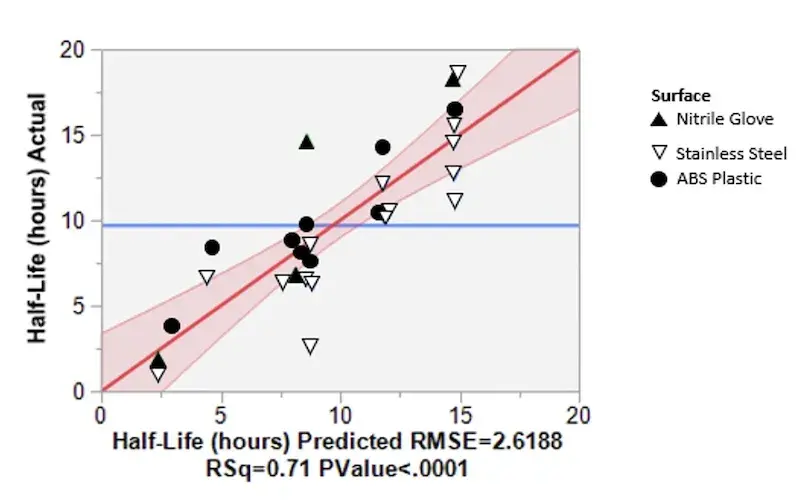under a range of temperatures, relative humidity, and UV index
Use the sliders to select the UV index, temperature and relative humidity of interest. Information on how long SARS-CoV-2 would be expected to remain stable in aerosols (airborne) will be displayed in the table below. Users can find the environmental conditions for a specific location by accessing general weather resources online.
SARS-CoV-2 Airborne Decay Calculator
COVID Stability:
| % Virus Decay | Minutes | Hours |
|---|---|---|
| 50% (half-life): | 11.32 | 0.47 |
| 90%: | 150.39 | 6.27 |
| 99%: | 225.59 | 9.40 |
- Preventing person-to-person spread of SARS-CoV-2 is the only means to reduce the impact of COVID-19 in the absence of an effective therapeutic.
- Transmission occurs primarily through respiratory droplets produced by talking, coughing and sneezing.
- Contact with contaminated surfaces and objects may also contribute to spread.
- SARS-CoV-2 will survive in saliva and respiratory fluids on surfaces for extended periods of time under certain conditions.
- DHS S&T has studied the stability of SARS-CoV-2 in simulated saliva, using droplets of varying size deposited on a non-porous surface under a range of temperature and RH conditions.
- Viral survival on surfaces is driven by temperature, relative humidity (RH), sunlight (UV), and matrix (e.g., bodily fluids).
- These data have been used to develop a predictive model to estimate virus decay under a limited range of environmental conditions.
- Testing performed on non-porous surfaces, specifically stainless steel, ABS plastic, and nitrile rubber.
- There was no significant difference found in the decay of the virus found between stainless steel ABS plastic, and nitrile rubber.
- For additional information and details on methodology for the research on the impact of temperature and relative humidity on SARS-CoV-2 decay on surfaces, please see the article titled, “Increasing Temperature and Relative Humidity Accelerates Inactivation of SARS-CoV-2 on Surfaces” published in the American Society for Microbiology journal.
- Research to determine impact of UV exposure on SARS-CoV-2 decay on surfaces was conducted at one temperature/relative humidity parameter. For additional information and details on methodology, please see the article titled, “Simulated Sunlight Rapidly Inactivates SARS-CoV-2 on Surfaces” published in the Journal of Infectious Diseases.

- Infectious dose is unknown (how much makes a person sick)
- Virus shedding is unknown (how much a sick person puts into the environment)
- Contact Hazard (how much virus comes off from touching surfaces)
This tool is valid for the following ranges of conditions:
- Without exposure to sunlight (UV 0): temperature (74°F to 95°F) and relative humidity from 20-60%.
- With exposure to sunlight (UV 1.5-12): temperature 68°F and relative humidity 20%.
S&T is partnering with CWMD to develop a tool that is easily accessible could be used by Occupational Safety and Health (OSH) professionals to support risk assessment, cleaning and disinfection in accordance with guidance provided by CDC and EPA including Guidance for Cleaning and Disinfecting: Public Spaces, Workplaces, Businesses, Schools, and Homes.
